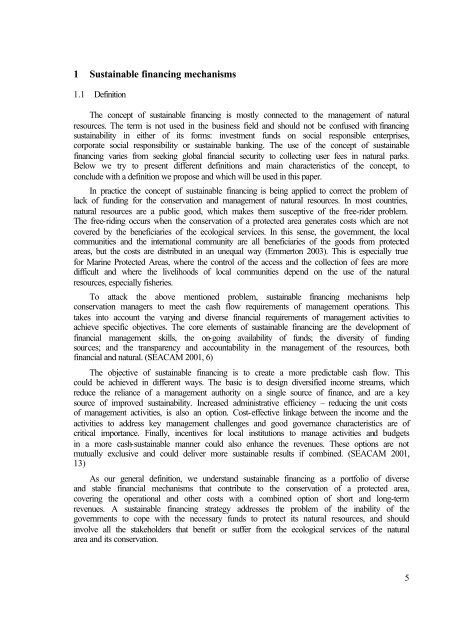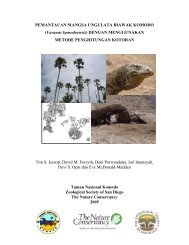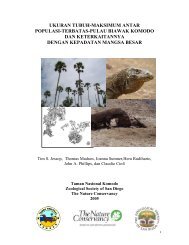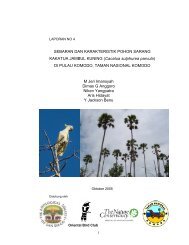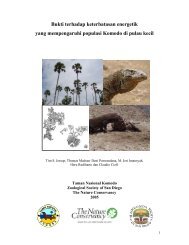Sustainable Financing of MPAs - Komodo National Park
Sustainable Financing of MPAs - Komodo National Park
Sustainable Financing of MPAs - Komodo National Park
You also want an ePaper? Increase the reach of your titles
YUMPU automatically turns print PDFs into web optimized ePapers that Google loves.
1 <strong>Sustainable</strong> financing mechanisms<br />
1.1 Definition<br />
The concept <strong>of</strong> sustainable financing is mostly connected to the management <strong>of</strong> natural<br />
resources. The term is not used in the business field and should not be confused with financing<br />
sustainability in either <strong>of</strong> its forms: investment funds on social responsible enterprises,<br />
corporate social responsibility or sustainable banking. The use <strong>of</strong> the concept <strong>of</strong> sustainable<br />
financing varies from seeking global financial security to collecting user fees in natural parks.<br />
Below we try to present different definitions and main characteristics <strong>of</strong> the concept, to<br />
conclude with a definition we propose and which will be used in this paper.<br />
In practice the concept <strong>of</strong> sustainable financing is being applied to correct the problem <strong>of</strong><br />
lack <strong>of</strong> funding for the conservation and management <strong>of</strong> natural resources. In most countries,<br />
natural resources are a public good, which makes them susceptive <strong>of</strong> the free-rider problem.<br />
The free-riding occurs when the conservation <strong>of</strong> a protected area generates costs which are not<br />
covered by the beneficiaries <strong>of</strong> the ecological services. In this sense, the government, the local<br />
communities and the international community are all beneficiaries <strong>of</strong> the goods from protected<br />
areas, but the costs are distributed in an unequal way (Emmerton 2003). This is especially true<br />
for Marine Protected Areas, where the control <strong>of</strong> the access and the collection <strong>of</strong> fees are more<br />
difficult and where the livelihoods <strong>of</strong> local communities depend on the use <strong>of</strong> the natural<br />
resources, especially fisheries.<br />
To attack the above mentioned problem, sustainable financing mechanisms help<br />
conservation managers to meet the cash flow requirements <strong>of</strong> management operations. This<br />
takes into account the varying and diverse financial requirements <strong>of</strong> management activities to<br />
achieve specific objectives. The core elements <strong>of</strong> sustainable financing are the development <strong>of</strong><br />
financial management skills, the on-going availability <strong>of</strong> funds; the diversity <strong>of</strong> funding<br />
sources; and the transparency and accountability in the management <strong>of</strong> the resources, both<br />
financial and natural. (SEACAM 2001, 6)<br />
The objective <strong>of</strong> sustainable financing is to create a more predictable cash flow. This<br />
could be achieved in different ways. The basic is to design diversified income streams, which<br />
reduce the reliance <strong>of</strong> a management authority on a single source <strong>of</strong> finance, and are a key<br />
source <strong>of</strong> improved sustainability. Increased administrative efficiency – reducing the unit costs<br />
<strong>of</strong> management activities, is also an option. Cost-effective linkage between the income and the<br />
activities to address key management challenges and good governance characteristics are <strong>of</strong><br />
critical importance. Finally, incentives for local institutions to manage activities and budgets<br />
in a more cash-sustainable manner could also enhance the revenues. These options are not<br />
mutually exclusive and could deliver more sustainable results if combined. (SEACAM 2001,<br />
13)<br />
As our general definition, we understand sustainable financing as a portfolio <strong>of</strong> diverse<br />
and stable financial mechanisms that contribute to the conservation <strong>of</strong> a protected area,<br />
covering the operational and other costs with a combined option <strong>of</strong> short and long-term<br />
revenues. A sustainable financing strategy addresses the problem <strong>of</strong> the inability <strong>of</strong> the<br />
governments to cope with the necessary funds to protect its natural resources, and should<br />
involve all the stakeholders that benefit or suffer from the ecological services <strong>of</strong> the natural<br />
area and its conservation.<br />
5


